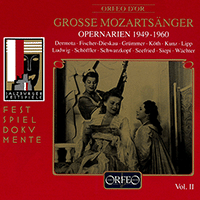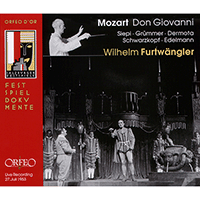Cesare Siepi
Siepi commenced singing as a member of a madrigal group; and though largely self-taught won a scholarship to the Milan Conservatory, where he studied briefly. When he was eighteen friends encouraged him to enter a singing competition in Florence. He won first prize and an impresario in the audience engaged him to sing Sparafucile / Rigoletto at Schio, near Venice, in 1941. A committed anti-fascist, Siepi fled to Switzerland in 1943 to avoid conscription by the Nazi forces occupying Italy. While interned his voice again attracted attention and he received some singing lessons in Lugano.
With the end of World War II, Siepi was able to resume his operatic career in 1945, enjoying immediate success as Zaccaria / Nabucco at La Fenice, Venice. During the following year, 1946, he made his debut at La Scala, Milan in the same role and was straight away set to work – he sang eight roles in his first season at La Scala. Quickly establishing himself as one of the leading basses in Italy, as well as elsewhere, he appeared at the Gran Teatro del Liceu, Barcelona in 1947 as Enrico / Anna Bolena; and in Mexico City in 1949 as Don Basilio / Il barbiere di Siviglia, Lothario / Mignon and Baldassare / La favorita. When Toscanini returned to La Scala in 1948 to conduct a concert commemorating the thirtieth anniversary of the death of Arrigo Boito, Siepi sang the title role in excerpts from Mefistofele and Simon Mago / Nerone. On the visit of the La Scala company to the United Kingdom in 1950 he sang Pistol / Falstaff, as well as in Verdi’s Requiem (conducted by De Sabata in London at the Royal Opera House) and in Mozart’s Requiem (conducted by Cantelli at that year’s Edinburgh Festival).
Immediately afterwards Siepi travelled to New York, where he made his Metropolitan Opera House debut as Philip II / Don Carlo (the inaugural production of Rudolf Bing’s reign there) in place of Boris Christoff, who was unable to secure a visa to work in the USA. During Bing’s time as general manager, Siepi was the leading bass at the Met, singing in nearly five hundred performances. Key roles included the title parts in Don Giovanni, Le nozze di Figaro and Boris Godunov; Zaccaria and Padre Guardiano / La forza del destino; Fiesco / Simon Boccanegra, Oroveso / Norma, Alvise / La Gioconda, Colline / La Bohème and Méphistophélès / Faust (Gounod). Relatively late in his time at the Met he sang Gurnemanz / Parsifal in 1970 and his final appearance there was as Don Basilio in 1973. Siepi also sang with the San Francisco Opera: for the first time in 1954, as Padre Guardiano and later Don Giovanni in 1981 and Don Basilio in 1982.
In Europe he became extremely well known for his interpretation of Don Giovanni which he sang at the Salzburg Festival in 1953 and 1954 (filmed) with Furtwängler conducting and in 1956 with Mitropoulos on the podium. He returned to Salzburg in 1958 to sing Philip II under Karajan. He was a frequent guest at the Vienna State Opera where he sang over forty performances of Don Giovanni, as well as Don Basilio, Colline, Fiesco, Figaro (Mozart), Padre Guardiano, Gurnemanz, Philip II, Méphistophélès and Ramphis / Aida. His final appearance in Vienna was as Oroveso in 1994 at the Austria Centre. He took the title role in the 1962 first run of Zeffirelli’s production of Don Giovanni at the Royal Opera House, London conducted by Solti and then returned to take the lead once again in another new production of the same work, by John Copley in 1973, conducted by Colin Davis.
After Siepi’s departure from the Met, his career had a second flowering in Italy: he appeared at the Verona Festival as Ramphis in 1980, at the Ravenna and Macerata Festivals as Philip II in 1983, as Fiesco at Ravenna in 1984, as Lothario / Mignon at the Teatro Communale, Florence in 1983, as Pagano / I Lombardi at Parma in 1985 and at Naples as Philip II once again in 1986. Other roles which he sang during this period included the title roles in Mosé (Rossini) and Marino Faliero (Donizetti), Seneca / L’incoronazione di Poppea (Monteverdi) and Dosifey / Khovanshchina. He made his farewell to the operatic stage as late as 1989, at the Teatro Carani in Sassuolo, Modena.
Siepi cut a handsome figure on stage, being tall and lithe. He was frequently compared with Ezio Pinza and like him appeared on Broadway, in Bravo Giovanni (1962) and Carmelina (1979), if without the same level of success. His voice was warm, flexible and evenly produced throughout the bass range. The growth of the long-playing record during the 1950s coincided with the development of his own international career and he recorded extensively, notably for the Decca label.
© Naxos Rights International Ltd. — David Patmore (A–Z of Singers, Naxos 8.558097-100).




















